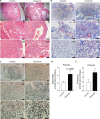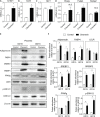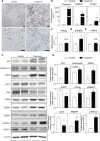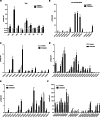Adipokine chemerin overexpression in trophoblasts leads to dyslipidemia in pregnant mice: implications for preeclampsia
- PMID: 36698175
- PMCID: PMC9875463
- DOI: 10.1186/s12944-023-01777-4
Adipokine chemerin overexpression in trophoblasts leads to dyslipidemia in pregnant mice: implications for preeclampsia
Abstract
Background: The adipokine chemerin regulates adipogenesis and the metabolic function of both adipocytes and liver. Chemerin is elevated in preeclamptic women, and overexpression of chemerin in placental trophoblasts induces preeclampsia-like symptoms in mice. Preeclampsia is known to be accompanied by dyslipidemia, albeit via unknown mechanisms. Here, we hypothesized that chemerin might be a contributor to dyslipidemia.
Methods: Serum lipid fractions as well as lipid-related genes and proteins were determined in pregnant mice with chemerin overexpression in placental trophoblasts and chemerin-overexpressing human trophoblasts. In addition, a phospholipidomics analysis was performed in chemerin-overexpressing trophoblasts.
Results: Overexpression of chemerin in trophoblasts increased the circulating and placental levels of cholesterol rather than triglycerides. It also increased the serum levels of lysophosphatidic acid, high-density lipoprotein cholesterol (HDL-C), and and low-density lipoprotein cholesterol (LDL-C), and induced placental lipid accumulation. Mechanistically, chemerin upregulated the levels of peroxisome proliferator-activated receptor g, fatty acid-binding protein 4, adiponectin, sterol regulatory element-binding protein 1 and 2, and the ratio of phosphorylated extracellular signal-regulated protein kinase (ERK)1/2 / total ERK1/2 in the placenta of mice and human trophoblasts. Furthermore, chemerin overexpression in human trophoblasts increased the production of lysophospholipids and phospholipids, particularly lysophosphatidylethanolamine.
Conclusions: Overexpression of placental chemerin production disrupts trophoblast lipid metabolism, thereby potentially contributing to dyslipidemia in preeclampsia.
Keywords: Chemerin; Dyslipidemia; Phospholipids; Placenta; Preeclampsia; Trophoblast.
© 2023. The Author(s).
Conflict of interest statement
The authors declare that they have no competing interests.
Figures






Similar articles
-
Statins Prevent the Deleterious Consequences of Placental Chemerin Upregulation in Preeclampsia.Hypertension. 2024 Apr;81(4):861-875. doi: 10.1161/HYPERTENSIONAHA.123.22457. Epub 2024 Feb 15. Hypertension. 2024. PMID: 38361240 Free PMC article.
-
Placental trophoblast-specific overexpression of chemerin induces preeclampsia-like symptoms.Clin Sci (Lond). 2022 Feb 25;136(4):257-272. doi: 10.1042/CS20210989. Clin Sci (Lond). 2022. PMID: 35103285 Free PMC article.
-
Chemerin sustains the growth of spongiotrophoblast and sinusoidal trophoblast giant cells through fatty acid oxidation.BMC Biol. 2025 Jul 3;23(1):199. doi: 10.1186/s12915-025-02294-9. BMC Biol. 2025. PMID: 40611253 Free PMC article.
-
An integrated model of preeclampsia: a multifaceted syndrome of the maternal cardiovascular-placental-fetal array.Am J Obstet Gynecol. 2022 Feb;226(2S):S963-S972. doi: 10.1016/j.ajog.2020.10.023. Epub 2021 Mar 9. Am J Obstet Gynecol. 2022. PMID: 33712272 Review.
-
The role of serum adipokine levels in preeclampsia: A systematic review.Metabolism. 2020 May;106:154172. doi: 10.1016/j.metabol.2020.154172. Epub 2020 Feb 4. Metabolism. 2020. PMID: 32027908
Cited by
-
Adipokines in preeclampsia: disrupted signaling pathways and novel therapeutic strategies.Eur J Med Res. 2025 Aug 4;30(1):702. doi: 10.1186/s40001-025-02972-y. Eur J Med Res. 2025. PMID: 40759967 Free PMC article. Review.
-
Chemerin and Polycystic Ovary Syndrome: A Comprehensive Review of Its Role as a Biomarker and Therapeutic Target.Biomedicines. 2024 Dec 16;12(12):2859. doi: 10.3390/biomedicines12122859. Biomedicines. 2024. PMID: 39767764 Free PMC article. Review.
-
Statins Prevent the Deleterious Consequences of Placental Chemerin Upregulation in Preeclampsia.Hypertension. 2024 Apr;81(4):861-875. doi: 10.1161/HYPERTENSIONAHA.123.22457. Epub 2024 Feb 15. Hypertension. 2024. PMID: 38361240 Free PMC article.
-
Statins, but not proprotein convertase subtilisin-kexin type 9 inhibitors, lower chemerin in hypercholesterolemia via low-density lipoprotein receptor upregulation.MedComm (2020). 2024 Aug 31;5(9):e681. doi: 10.1002/mco2.681. eCollection 2024 Sep. MedComm (2020). 2024. PMID: 39220103 Free PMC article.
-
The Role of Chemerin in Metabolic and Cardiovascular Disease: A Literature Review of Its Physiology and Pathology from a Nutritional Perspective.Nutrients. 2023 Jun 25;15(13):2878. doi: 10.3390/nu15132878. Nutrients. 2023. PMID: 37447205 Free PMC article. Review.
References
-
- Rana S, Lemoine E, Granger JP, Karumanchi SA. Preeclampsia: pathophysiology, challenges, and perspectives. Circ Res. 2019;124:1094–1112. - PubMed
-
- Hypertension in pregnancy Report of the American College of Obstetricians and Gynecologists' task force on hypertension in pregnancy. Obstet Gynecol. 2013;122:1122–1131. - PubMed
-
- ACOG Practice Bulletin No 202 summary: gestational hypertension and preeclampsia. Obstet Gynecol. 2019;133:1. - PubMed
-
- Duan DM, Niu JM, Lei Q, Lin XH, Chen X. Serum levels of the adipokine chemerin in preeclampsia. J Perinat Med. 2011;40:121–127. - PubMed
-
- Clausen T, Djurovic S, Henriksen T. Dyslipidemia in early second trimester is mainly a feature of women with early onset pre-eclampsia. BJOG. 2001;108:1081–1087. - PubMed
MeSH terms
Substances
LinkOut - more resources
Full Text Sources
Research Materials
Miscellaneous

